Organizational Culture and HRM: A Crosscultural Management Case Study
VerifiedAdded on 2022/12/30
|9
|2752
|94
Case Study
AI Summary
This case study analyzes cross-cultural management issues within the context of Brett Jones' experiences in Tanzania. The report delves into the challenges of organizational culture, highlighting the impact of differing values, beliefs, and language barriers within the workforce, and how these factors influence business practices. It examines the role of organizational structure and its impact on information flow and performance, recommending functional structures for clarity. Furthermore, the study addresses motivation and human resource management, emphasizing the need for effective strategies to address workforce diversity, training, and the potential for nepotism, offering recommendations for improvement. The conclusion underscores the importance of cross-cultural management in achieving organizational goals.
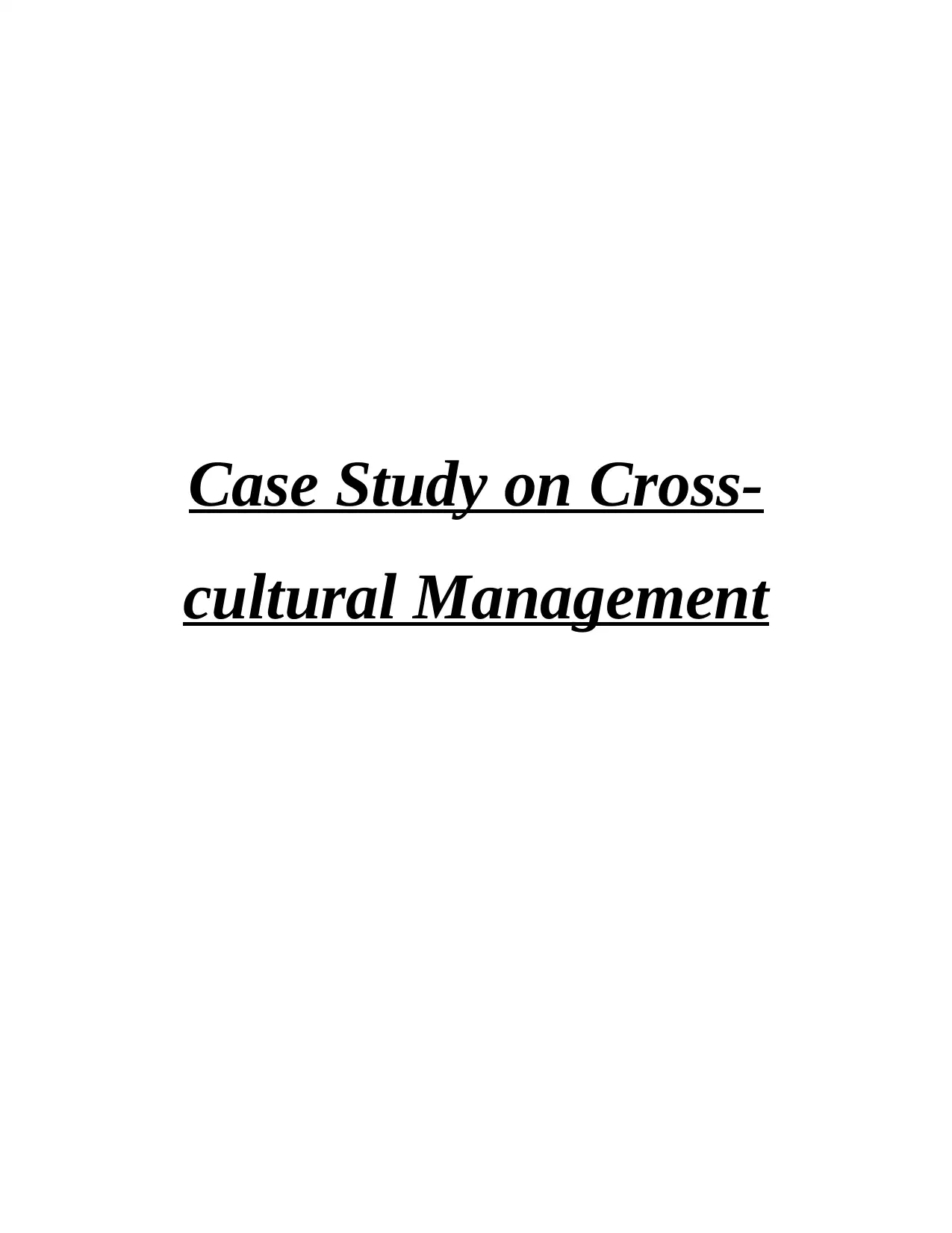
Case Study on Cross-
cultural Management
cultural Management
Paraphrase This Document
Need a fresh take? Get an instant paraphrase of this document with our AI Paraphraser
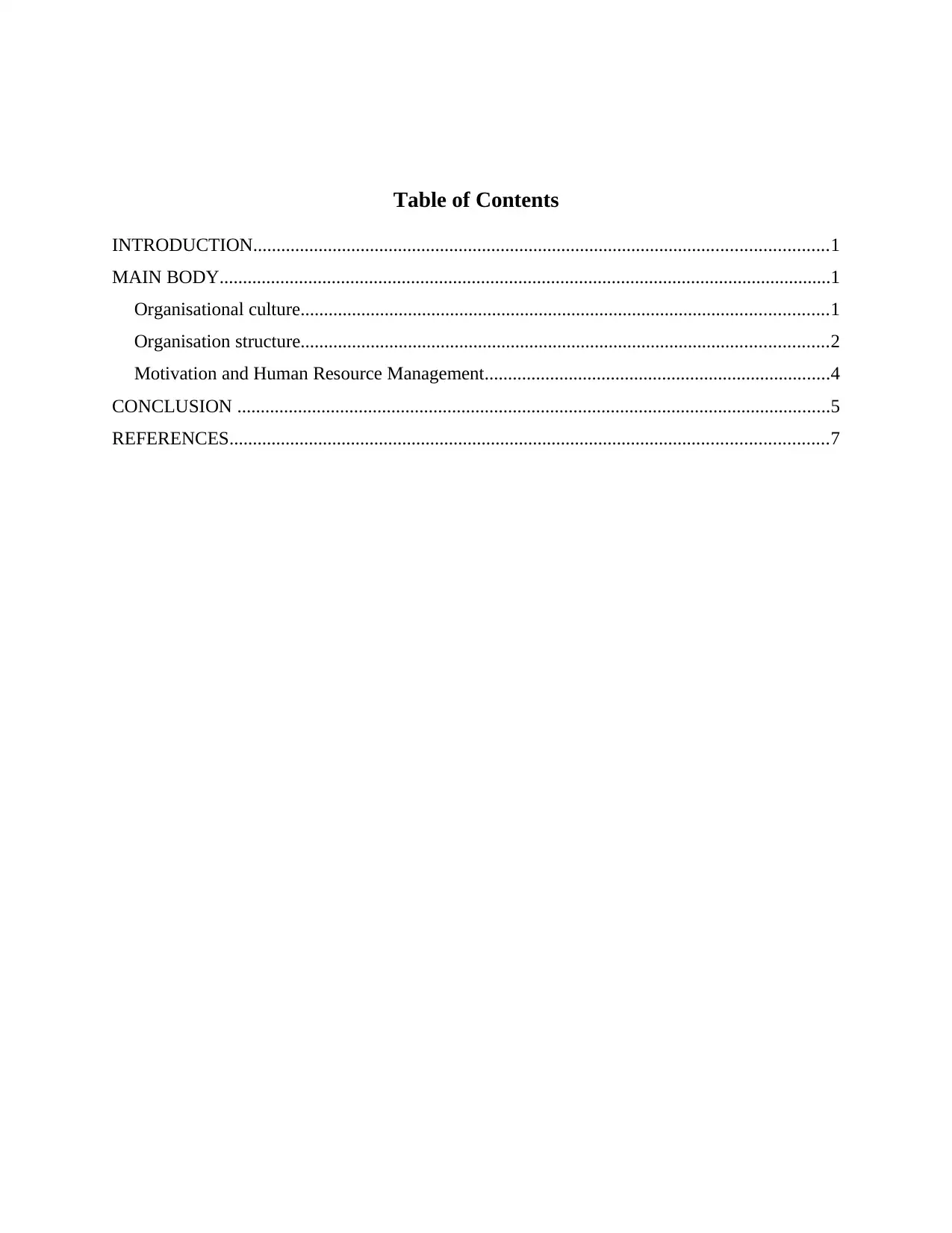
Table of Contents
INTRODUCTION...........................................................................................................................1
MAIN BODY...................................................................................................................................1
Organisational culture.................................................................................................................1
Organisation structure.................................................................................................................2
Motivation and Human Resource Management..........................................................................4
CONCLUSION ...............................................................................................................................5
REFERENCES................................................................................................................................7
INTRODUCTION...........................................................................................................................1
MAIN BODY...................................................................................................................................1
Organisational culture.................................................................................................................1
Organisation structure.................................................................................................................2
Motivation and Human Resource Management..........................................................................4
CONCLUSION ...............................................................................................................................5
REFERENCES................................................................................................................................7
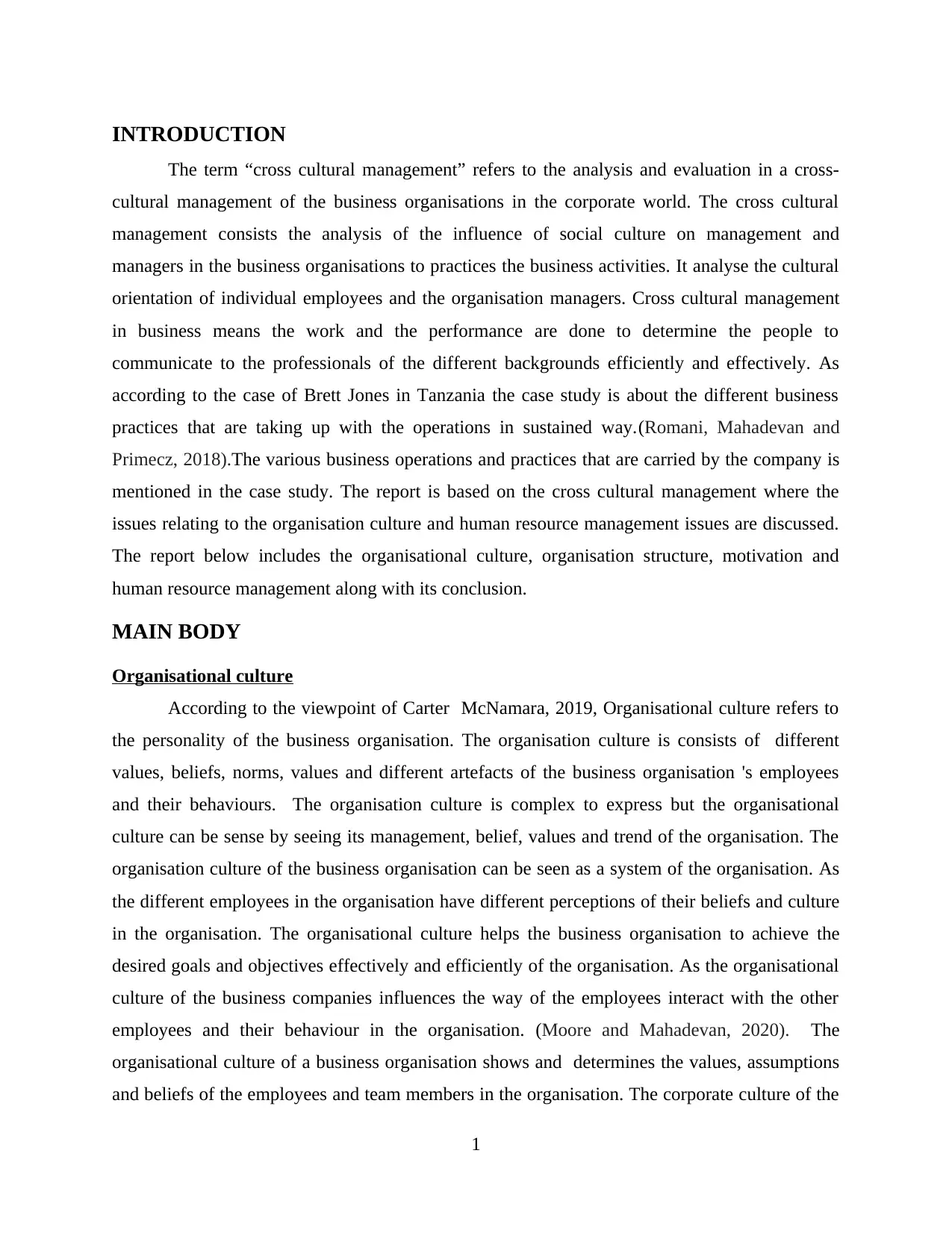
INTRODUCTION
The term “cross cultural management” refers to the analysis and evaluation in a cross-
cultural management of the business organisations in the corporate world. The cross cultural
management consists the analysis of the influence of social culture on management and
managers in the business organisations to practices the business activities. It analyse the cultural
orientation of individual employees and the organisation managers. Cross cultural management
in business means the work and the performance are done to determine the people to
communicate to the professionals of the different backgrounds efficiently and effectively. As
according to the case of Brett Jones in Tanzania the case study is about the different business
practices that are taking up with the operations in sustained way.(Romani, Mahadevan and
Primecz, 2018).The various business operations and practices that are carried by the company is
mentioned in the case study. The report is based on the cross cultural management where the
issues relating to the organisation culture and human resource management issues are discussed.
The report below includes the organisational culture, organisation structure, motivation and
human resource management along with its conclusion.
MAIN BODY
Organisational culture
According to the viewpoint of Carter McNamara, 2019, Organisational culture refers to
the personality of the business organisation. The organisation culture is consists of different
values, beliefs, norms, values and different artefacts of the business organisation 's employees
and their behaviours. The organisation culture is complex to express but the organisational
culture can be sense by seeing its management, belief, values and trend of the organisation. The
organisation culture of the business organisation can be seen as a system of the organisation. As
the different employees in the organisation have different perceptions of their beliefs and culture
in the organisation. The organisational culture helps the business organisation to achieve the
desired goals and objectives effectively and efficiently of the organisation. As the organisational
culture of the business companies influences the way of the employees interact with the other
employees and their behaviour in the organisation. (Moore and Mahadevan, 2020). The
organisational culture of a business organisation shows and determines the values, assumptions
and beliefs of the employees and team members in the organisation. The corporate culture of the
1
The term “cross cultural management” refers to the analysis and evaluation in a cross-
cultural management of the business organisations in the corporate world. The cross cultural
management consists the analysis of the influence of social culture on management and
managers in the business organisations to practices the business activities. It analyse the cultural
orientation of individual employees and the organisation managers. Cross cultural management
in business means the work and the performance are done to determine the people to
communicate to the professionals of the different backgrounds efficiently and effectively. As
according to the case of Brett Jones in Tanzania the case study is about the different business
practices that are taking up with the operations in sustained way.(Romani, Mahadevan and
Primecz, 2018).The various business operations and practices that are carried by the company is
mentioned in the case study. The report is based on the cross cultural management where the
issues relating to the organisation culture and human resource management issues are discussed.
The report below includes the organisational culture, organisation structure, motivation and
human resource management along with its conclusion.
MAIN BODY
Organisational culture
According to the viewpoint of Carter McNamara, 2019, Organisational culture refers to
the personality of the business organisation. The organisation culture is consists of different
values, beliefs, norms, values and different artefacts of the business organisation 's employees
and their behaviours. The organisation culture is complex to express but the organisational
culture can be sense by seeing its management, belief, values and trend of the organisation. The
organisation culture of the business organisation can be seen as a system of the organisation. As
the different employees in the organisation have different perceptions of their beliefs and culture
in the organisation. The organisational culture helps the business organisation to achieve the
desired goals and objectives effectively and efficiently of the organisation. As the organisational
culture of the business companies influences the way of the employees interact with the other
employees and their behaviour in the organisation. (Moore and Mahadevan, 2020). The
organisational culture of a business organisation shows and determines the values, assumptions
and beliefs of the employees and team members in the organisation. The corporate culture of the
1
You're viewing a preview
Unlock full access by subscribing today!
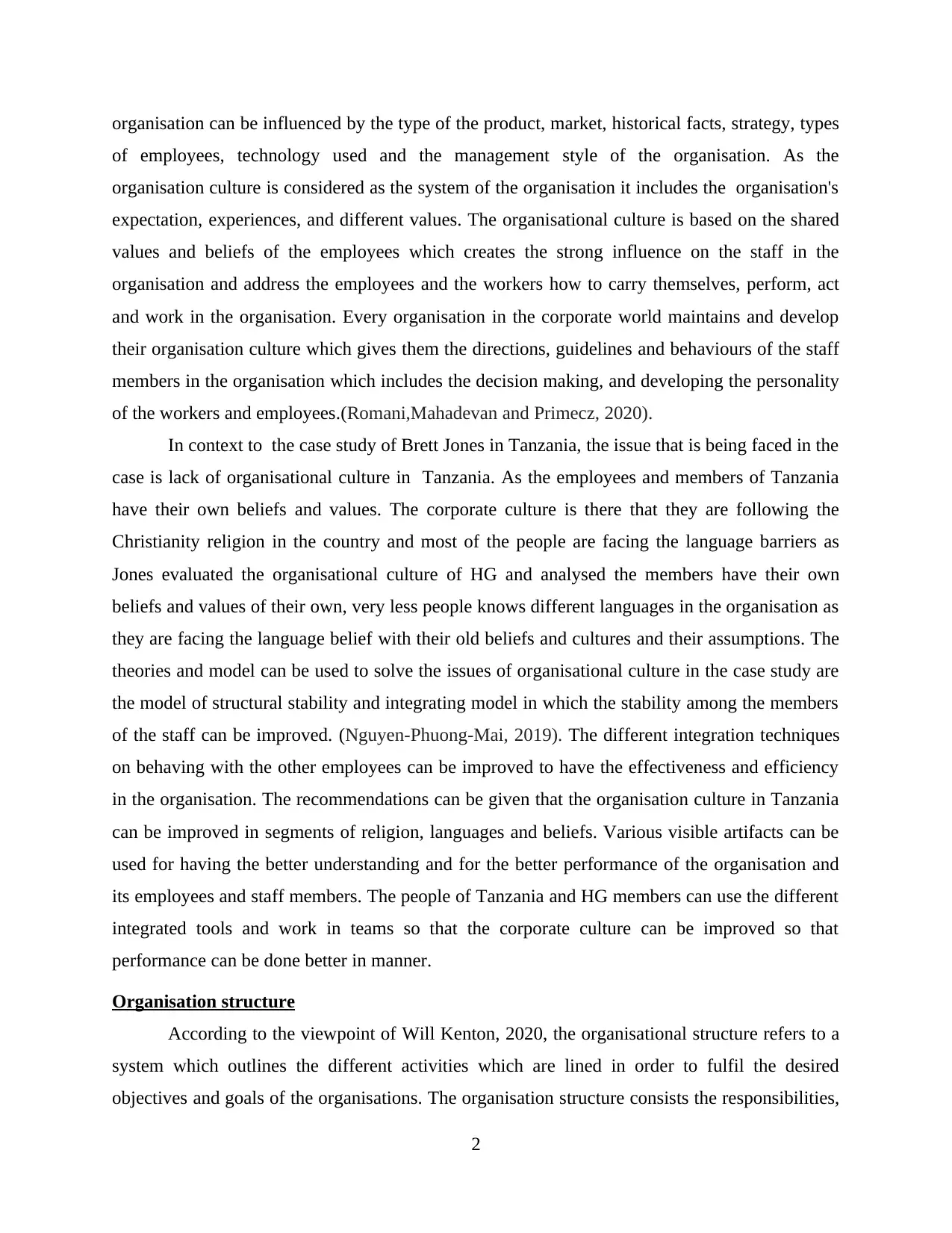
organisation can be influenced by the type of the product, market, historical facts, strategy, types
of employees, technology used and the management style of the organisation. As the
organisation culture is considered as the system of the organisation it includes the organisation's
expectation, experiences, and different values. The organisational culture is based on the shared
values and beliefs of the employees which creates the strong influence on the staff in the
organisation and address the employees and the workers how to carry themselves, perform, act
and work in the organisation. Every organisation in the corporate world maintains and develop
their organisation culture which gives them the directions, guidelines and behaviours of the staff
members in the organisation which includes the decision making, and developing the personality
of the workers and employees.(Romani,Mahadevan and Primecz, 2020).
In context to the case study of Brett Jones in Tanzania, the issue that is being faced in the
case is lack of organisational culture in Tanzania. As the employees and members of Tanzania
have their own beliefs and values. The corporate culture is there that they are following the
Christianity religion in the country and most of the people are facing the language barriers as
Jones evaluated the organisational culture of HG and analysed the members have their own
beliefs and values of their own, very less people knows different languages in the organisation as
they are facing the language belief with their old beliefs and cultures and their assumptions. The
theories and model can be used to solve the issues of organisational culture in the case study are
the model of structural stability and integrating model in which the stability among the members
of the staff can be improved. (Nguyen-Phuong-Mai, 2019). The different integration techniques
on behaving with the other employees can be improved to have the effectiveness and efficiency
in the organisation. The recommendations can be given that the organisation culture in Tanzania
can be improved in segments of religion, languages and beliefs. Various visible artifacts can be
used for having the better understanding and for the better performance of the organisation and
its employees and staff members. The people of Tanzania and HG members can use the different
integrated tools and work in teams so that the corporate culture can be improved so that
performance can be done better in manner.
Organisation structure
According to the viewpoint of Will Kenton, 2020, the organisational structure refers to a
system which outlines the different activities which are lined in order to fulfil the desired
objectives and goals of the organisations. The organisation structure consists the responsibilities,
2
of employees, technology used and the management style of the organisation. As the
organisation culture is considered as the system of the organisation it includes the organisation's
expectation, experiences, and different values. The organisational culture is based on the shared
values and beliefs of the employees which creates the strong influence on the staff in the
organisation and address the employees and the workers how to carry themselves, perform, act
and work in the organisation. Every organisation in the corporate world maintains and develop
their organisation culture which gives them the directions, guidelines and behaviours of the staff
members in the organisation which includes the decision making, and developing the personality
of the workers and employees.(Romani,Mahadevan and Primecz, 2020).
In context to the case study of Brett Jones in Tanzania, the issue that is being faced in the
case is lack of organisational culture in Tanzania. As the employees and members of Tanzania
have their own beliefs and values. The corporate culture is there that they are following the
Christianity religion in the country and most of the people are facing the language barriers as
Jones evaluated the organisational culture of HG and analysed the members have their own
beliefs and values of their own, very less people knows different languages in the organisation as
they are facing the language belief with their old beliefs and cultures and their assumptions. The
theories and model can be used to solve the issues of organisational culture in the case study are
the model of structural stability and integrating model in which the stability among the members
of the staff can be improved. (Nguyen-Phuong-Mai, 2019). The different integration techniques
on behaving with the other employees can be improved to have the effectiveness and efficiency
in the organisation. The recommendations can be given that the organisation culture in Tanzania
can be improved in segments of religion, languages and beliefs. Various visible artifacts can be
used for having the better understanding and for the better performance of the organisation and
its employees and staff members. The people of Tanzania and HG members can use the different
integrated tools and work in teams so that the corporate culture can be improved so that
performance can be done better in manner.
Organisation structure
According to the viewpoint of Will Kenton, 2020, the organisational structure refers to a
system which outlines the different activities which are lined in order to fulfil the desired
objectives and goals of the organisations. The organisation structure consists the responsibilities,
2
Paraphrase This Document
Need a fresh take? Get an instant paraphrase of this document with our AI Paraphraser
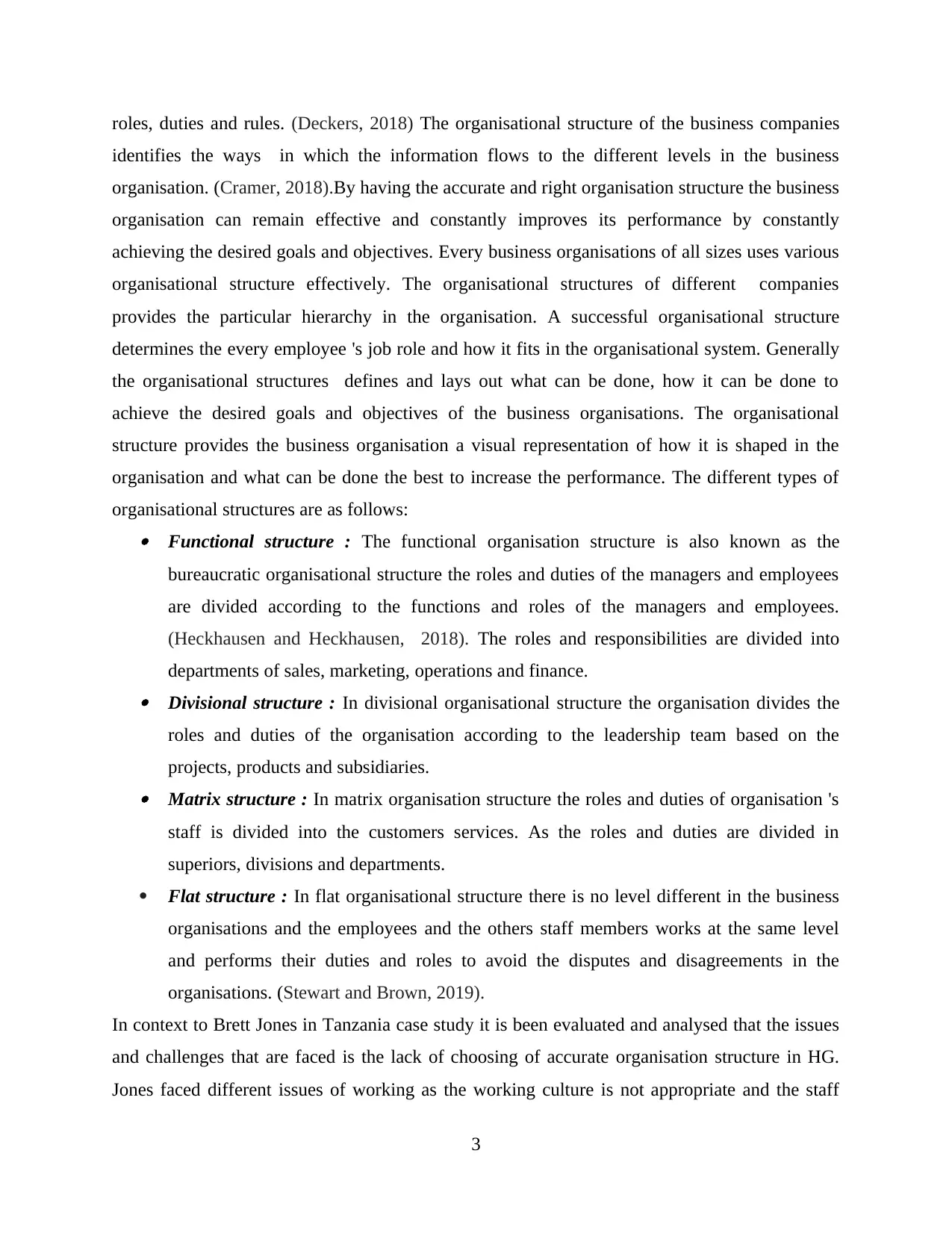
roles, duties and rules. (Deckers, 2018) The organisational structure of the business companies
identifies the ways in which the information flows to the different levels in the business
organisation. (Cramer, 2018).By having the accurate and right organisation structure the business
organisation can remain effective and constantly improves its performance by constantly
achieving the desired goals and objectives. Every business organisations of all sizes uses various
organisational structure effectively. The organisational structures of different companies
provides the particular hierarchy in the organisation. A successful organisational structure
determines the every employee 's job role and how it fits in the organisational system. Generally
the organisational structures defines and lays out what can be done, how it can be done to
achieve the desired goals and objectives of the business organisations. The organisational
structure provides the business organisation a visual representation of how it is shaped in the
organisation and what can be done the best to increase the performance. The different types of
organisational structures are as follows: Functional structure : The functional organisation structure is also known as the
bureaucratic organisational structure the roles and duties of the managers and employees
are divided according to the functions and roles of the managers and employees.
(Heckhausen and Heckhausen, 2018). The roles and responsibilities are divided into
departments of sales, marketing, operations and finance. Divisional structure : In divisional organisational structure the organisation divides the
roles and duties of the organisation according to the leadership team based on the
projects, products and subsidiaries. Matrix structure : In matrix organisation structure the roles and duties of organisation 's
staff is divided into the customers services. As the roles and duties are divided in
superiors, divisions and departments.
Flat structure : In flat organisational structure there is no level different in the business
organisations and the employees and the others staff members works at the same level
and performs their duties and roles to avoid the disputes and disagreements in the
organisations. (Stewart and Brown, 2019).
In context to Brett Jones in Tanzania case study it is been evaluated and analysed that the issues
and challenges that are faced is the lack of choosing of accurate organisation structure in HG.
Jones faced different issues of working as the working culture is not appropriate and the staff
3
identifies the ways in which the information flows to the different levels in the business
organisation. (Cramer, 2018).By having the accurate and right organisation structure the business
organisation can remain effective and constantly improves its performance by constantly
achieving the desired goals and objectives. Every business organisations of all sizes uses various
organisational structure effectively. The organisational structures of different companies
provides the particular hierarchy in the organisation. A successful organisational structure
determines the every employee 's job role and how it fits in the organisational system. Generally
the organisational structures defines and lays out what can be done, how it can be done to
achieve the desired goals and objectives of the business organisations. The organisational
structure provides the business organisation a visual representation of how it is shaped in the
organisation and what can be done the best to increase the performance. The different types of
organisational structures are as follows: Functional structure : The functional organisation structure is also known as the
bureaucratic organisational structure the roles and duties of the managers and employees
are divided according to the functions and roles of the managers and employees.
(Heckhausen and Heckhausen, 2018). The roles and responsibilities are divided into
departments of sales, marketing, operations and finance. Divisional structure : In divisional organisational structure the organisation divides the
roles and duties of the organisation according to the leadership team based on the
projects, products and subsidiaries. Matrix structure : In matrix organisation structure the roles and duties of organisation 's
staff is divided into the customers services. As the roles and duties are divided in
superiors, divisions and departments.
Flat structure : In flat organisational structure there is no level different in the business
organisations and the employees and the others staff members works at the same level
and performs their duties and roles to avoid the disputes and disagreements in the
organisations. (Stewart and Brown, 2019).
In context to Brett Jones in Tanzania case study it is been evaluated and analysed that the issues
and challenges that are faced is the lack of choosing of accurate organisation structure in HG.
Jones faced different issues of working as the working culture is not appropriate and the staff
3
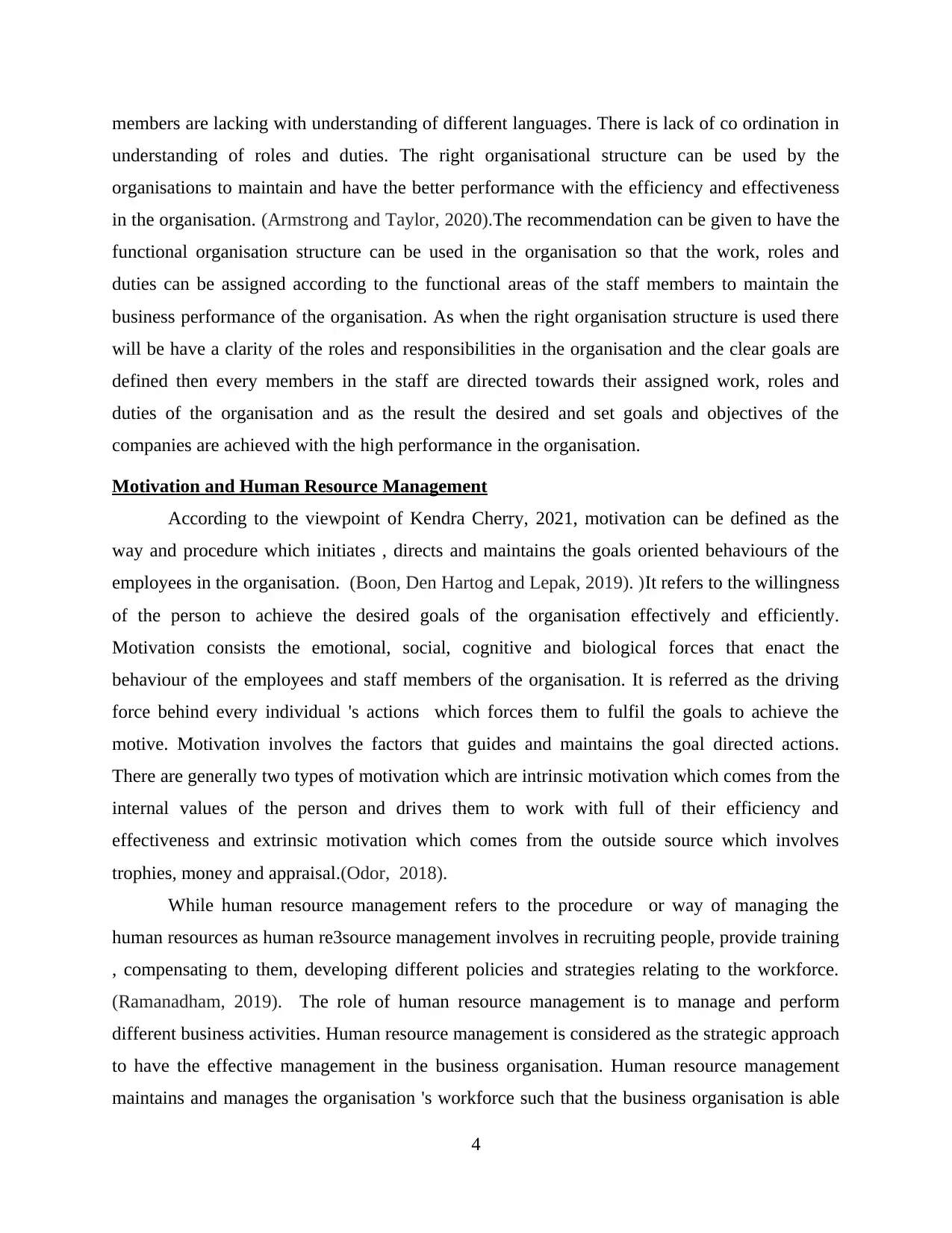
members are lacking with understanding of different languages. There is lack of co ordination in
understanding of roles and duties. The right organisational structure can be used by the
organisations to maintain and have the better performance with the efficiency and effectiveness
in the organisation. (Armstrong and Taylor, 2020).The recommendation can be given to have the
functional organisation structure can be used in the organisation so that the work, roles and
duties can be assigned according to the functional areas of the staff members to maintain the
business performance of the organisation. As when the right organisation structure is used there
will be have a clarity of the roles and responsibilities in the organisation and the clear goals are
defined then every members in the staff are directed towards their assigned work, roles and
duties of the organisation and as the result the desired and set goals and objectives of the
companies are achieved with the high performance in the organisation.
Motivation and Human Resource Management
According to the viewpoint of Kendra Cherry, 2021, motivation can be defined as the
way and procedure which initiates , directs and maintains the goals oriented behaviours of the
employees in the organisation. (Boon, Den Hartog and Lepak, 2019). )It refers to the willingness
of the person to achieve the desired goals of the organisation effectively and efficiently.
Motivation consists the emotional, social, cognitive and biological forces that enact the
behaviour of the employees and staff members of the organisation. It is referred as the driving
force behind every individual 's actions which forces them to fulfil the goals to achieve the
motive. Motivation involves the factors that guides and maintains the goal directed actions.
There are generally two types of motivation which are intrinsic motivation which comes from the
internal values of the person and drives them to work with full of their efficiency and
effectiveness and extrinsic motivation which comes from the outside source which involves
trophies, money and appraisal.(Odor, 2018).
While human resource management refers to the procedure or way of managing the
human resources as human re3source management involves in recruiting people, provide training
, compensating to them, developing different policies and strategies relating to the workforce.
(Ramanadham, 2019). The role of human resource management is to manage and perform
different business activities. Human resource management is considered as the strategic approach
to have the effective management in the business organisation. Human resource management
maintains and manages the organisation 's workforce such that the business organisation is able
4
understanding of roles and duties. The right organisational structure can be used by the
organisations to maintain and have the better performance with the efficiency and effectiveness
in the organisation. (Armstrong and Taylor, 2020).The recommendation can be given to have the
functional organisation structure can be used in the organisation so that the work, roles and
duties can be assigned according to the functional areas of the staff members to maintain the
business performance of the organisation. As when the right organisation structure is used there
will be have a clarity of the roles and responsibilities in the organisation and the clear goals are
defined then every members in the staff are directed towards their assigned work, roles and
duties of the organisation and as the result the desired and set goals and objectives of the
companies are achieved with the high performance in the organisation.
Motivation and Human Resource Management
According to the viewpoint of Kendra Cherry, 2021, motivation can be defined as the
way and procedure which initiates , directs and maintains the goals oriented behaviours of the
employees in the organisation. (Boon, Den Hartog and Lepak, 2019). )It refers to the willingness
of the person to achieve the desired goals of the organisation effectively and efficiently.
Motivation consists the emotional, social, cognitive and biological forces that enact the
behaviour of the employees and staff members of the organisation. It is referred as the driving
force behind every individual 's actions which forces them to fulfil the goals to achieve the
motive. Motivation involves the factors that guides and maintains the goal directed actions.
There are generally two types of motivation which are intrinsic motivation which comes from the
internal values of the person and drives them to work with full of their efficiency and
effectiveness and extrinsic motivation which comes from the outside source which involves
trophies, money and appraisal.(Odor, 2018).
While human resource management refers to the procedure or way of managing the
human resources as human re3source management involves in recruiting people, provide training
, compensating to them, developing different policies and strategies relating to the workforce.
(Ramanadham, 2019). The role of human resource management is to manage and perform
different business activities. Human resource management is considered as the strategic approach
to have the effective management in the business organisation. Human resource management
maintains and manages the organisation 's workforce such that the business organisation is able
4
You're viewing a preview
Unlock full access by subscribing today!
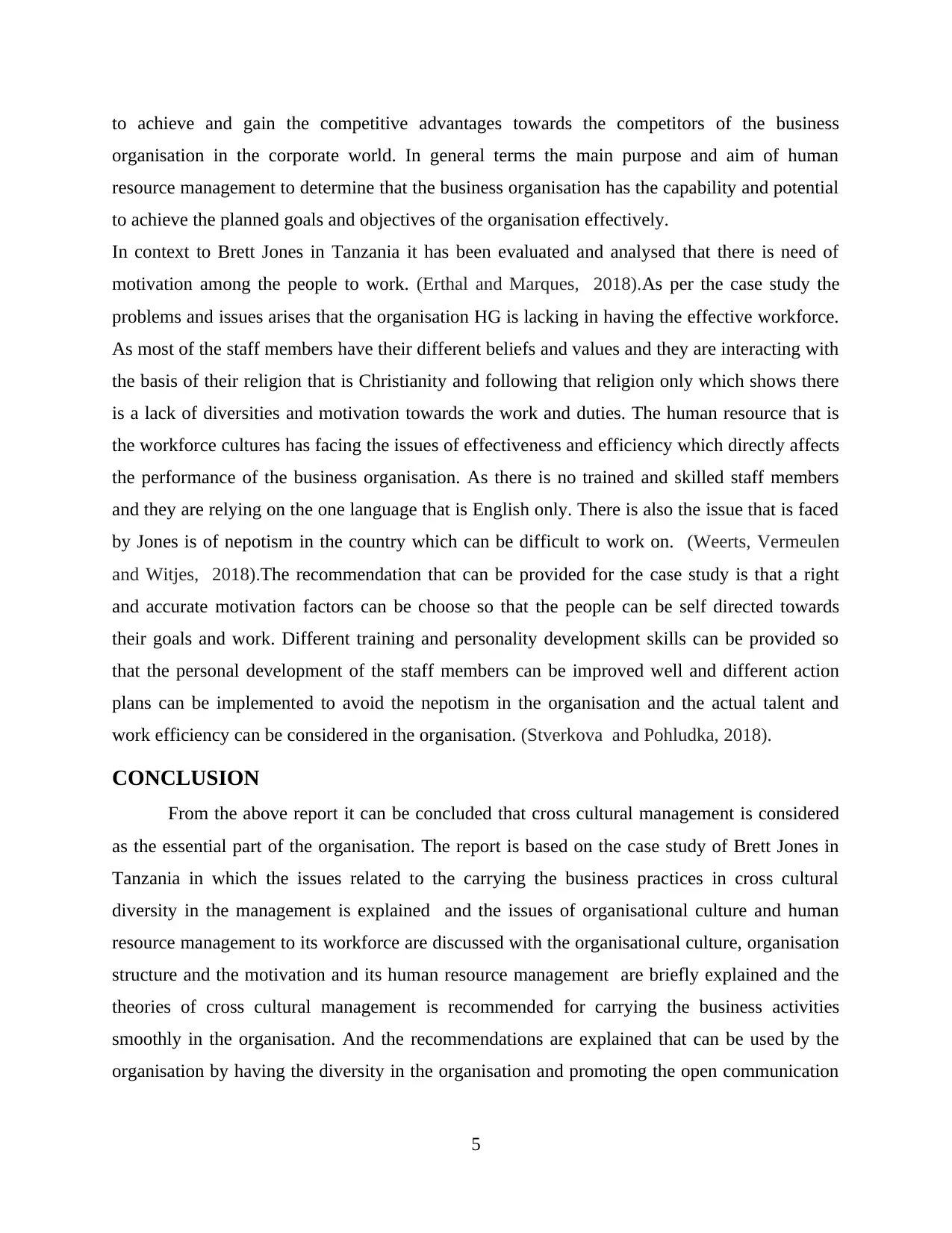
to achieve and gain the competitive advantages towards the competitors of the business
organisation in the corporate world. In general terms the main purpose and aim of human
resource management to determine that the business organisation has the capability and potential
to achieve the planned goals and objectives of the organisation effectively.
In context to Brett Jones in Tanzania it has been evaluated and analysed that there is need of
motivation among the people to work. (Erthal and Marques, 2018).As per the case study the
problems and issues arises that the organisation HG is lacking in having the effective workforce.
As most of the staff members have their different beliefs and values and they are interacting with
the basis of their religion that is Christianity and following that religion only which shows there
is a lack of diversities and motivation towards the work and duties. The human resource that is
the workforce cultures has facing the issues of effectiveness and efficiency which directly affects
the performance of the business organisation. As there is no trained and skilled staff members
and they are relying on the one language that is English only. There is also the issue that is faced
by Jones is of nepotism in the country which can be difficult to work on. (Weerts, Vermeulen
and Witjes, 2018).The recommendation that can be provided for the case study is that a right
and accurate motivation factors can be choose so that the people can be self directed towards
their goals and work. Different training and personality development skills can be provided so
that the personal development of the staff members can be improved well and different action
plans can be implemented to avoid the nepotism in the organisation and the actual talent and
work efficiency can be considered in the organisation. (Stverkova and Pohludka, 2018).
CONCLUSION
From the above report it can be concluded that cross cultural management is considered
as the essential part of the organisation. The report is based on the case study of Brett Jones in
Tanzania in which the issues related to the carrying the business practices in cross cultural
diversity in the management is explained and the issues of organisational culture and human
resource management to its workforce are discussed with the organisational culture, organisation
structure and the motivation and its human resource management are briefly explained and the
theories of cross cultural management is recommended for carrying the business activities
smoothly in the organisation. And the recommendations are explained that can be used by the
organisation by having the diversity in the organisation and promoting the open communication
5
organisation in the corporate world. In general terms the main purpose and aim of human
resource management to determine that the business organisation has the capability and potential
to achieve the planned goals and objectives of the organisation effectively.
In context to Brett Jones in Tanzania it has been evaluated and analysed that there is need of
motivation among the people to work. (Erthal and Marques, 2018).As per the case study the
problems and issues arises that the organisation HG is lacking in having the effective workforce.
As most of the staff members have their different beliefs and values and they are interacting with
the basis of their religion that is Christianity and following that religion only which shows there
is a lack of diversities and motivation towards the work and duties. The human resource that is
the workforce cultures has facing the issues of effectiveness and efficiency which directly affects
the performance of the business organisation. As there is no trained and skilled staff members
and they are relying on the one language that is English only. There is also the issue that is faced
by Jones is of nepotism in the country which can be difficult to work on. (Weerts, Vermeulen
and Witjes, 2018).The recommendation that can be provided for the case study is that a right
and accurate motivation factors can be choose so that the people can be self directed towards
their goals and work. Different training and personality development skills can be provided so
that the personal development of the staff members can be improved well and different action
plans can be implemented to avoid the nepotism in the organisation and the actual talent and
work efficiency can be considered in the organisation. (Stverkova and Pohludka, 2018).
CONCLUSION
From the above report it can be concluded that cross cultural management is considered
as the essential part of the organisation. The report is based on the case study of Brett Jones in
Tanzania in which the issues related to the carrying the business practices in cross cultural
diversity in the management is explained and the issues of organisational culture and human
resource management to its workforce are discussed with the organisational culture, organisation
structure and the motivation and its human resource management are briefly explained and the
theories of cross cultural management is recommended for carrying the business activities
smoothly in the organisation. And the recommendations are explained that can be used by the
organisation by having the diversity in the organisation and promoting the open communication
5
Paraphrase This Document
Need a fresh take? Get an instant paraphrase of this document with our AI Paraphraser
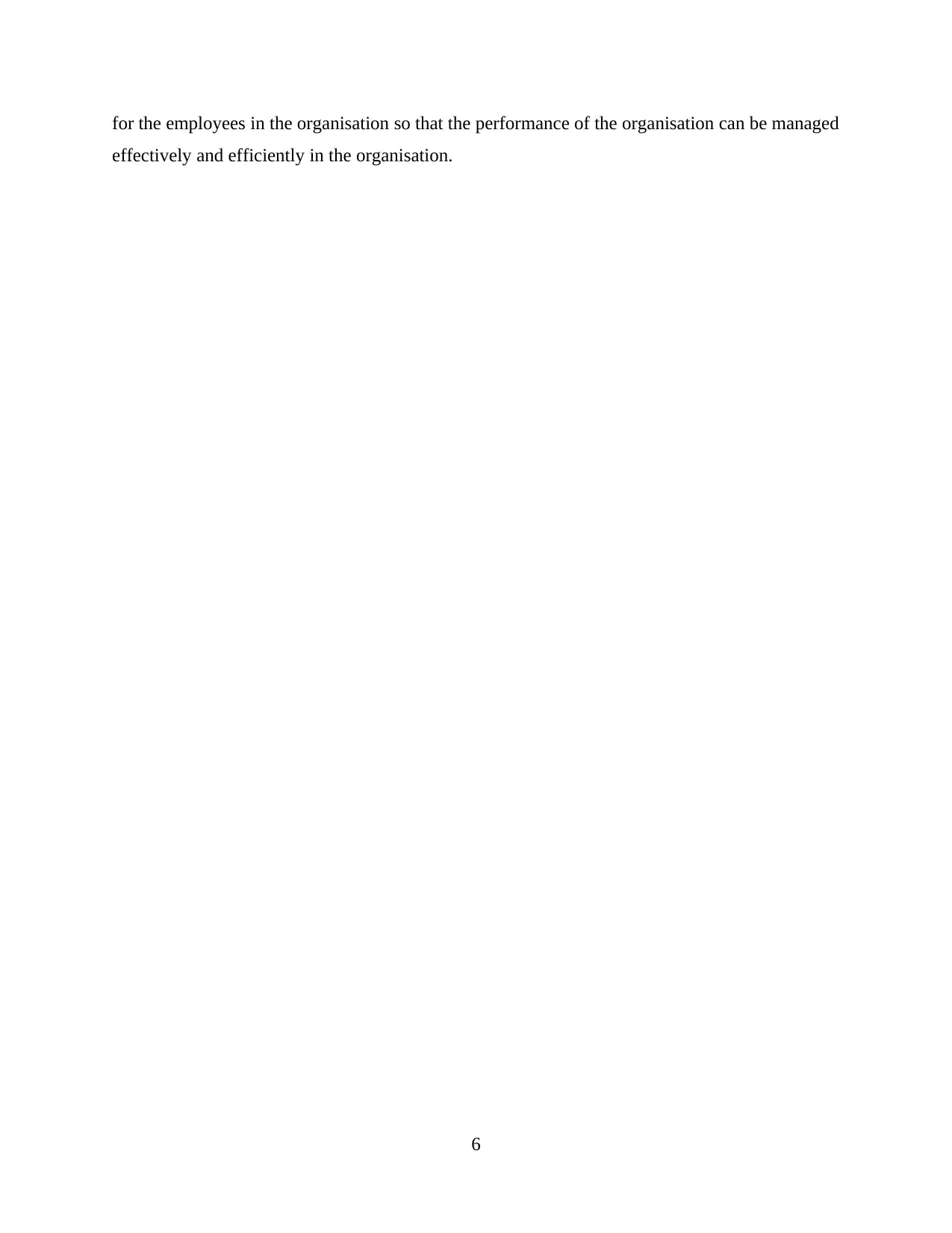
for the employees in the organisation so that the performance of the organisation can be managed
effectively and efficiently in the organisation.
6
effectively and efficiently in the organisation.
6
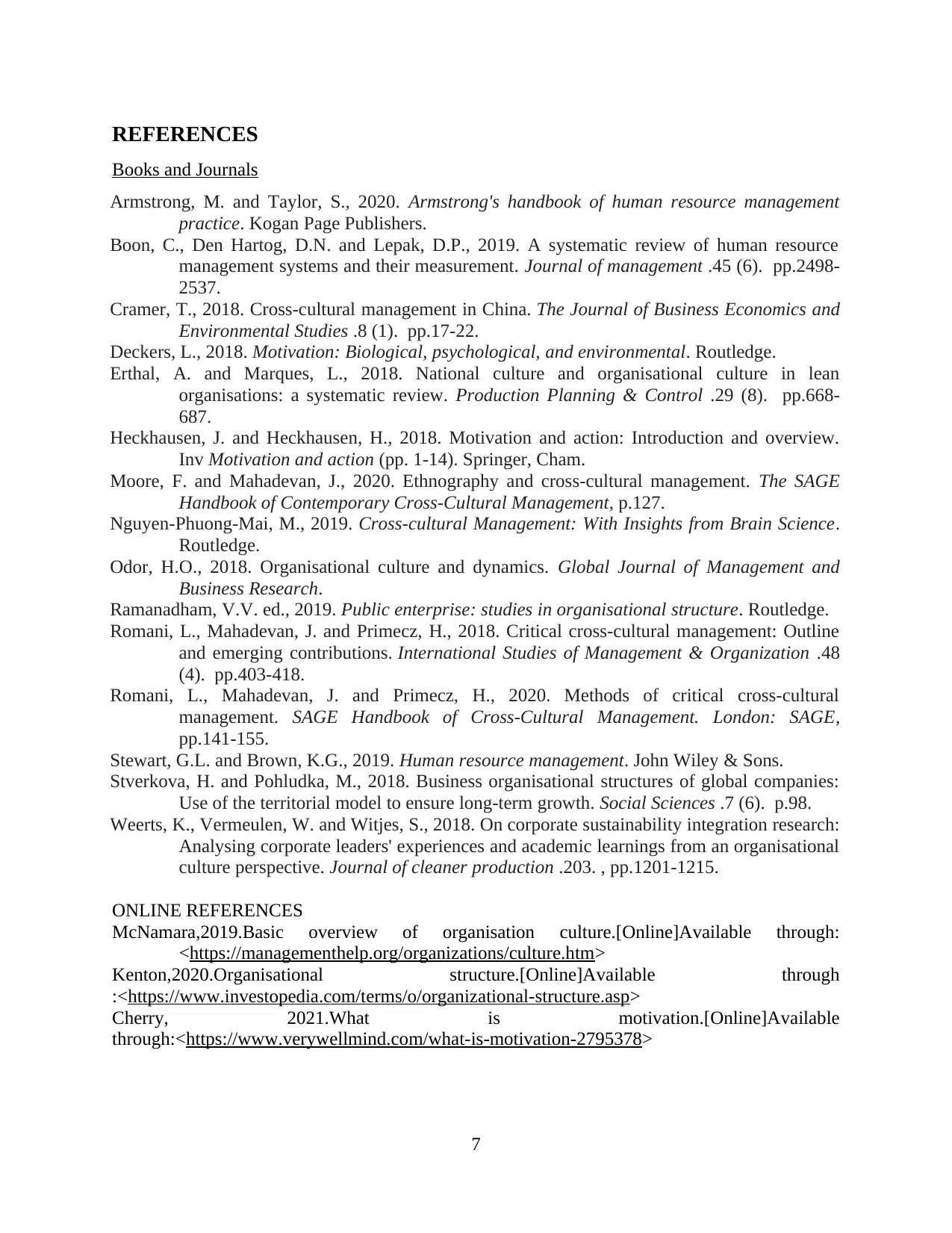
REFERENCES
Books and Journals
Armstrong, M. and Taylor, S., 2020. Armstrong's handbook of human resource management
practice. Kogan Page Publishers.
Boon, C., Den Hartog, D.N. and Lepak, D.P., 2019. A systematic review of human resource
management systems and their measurement. Journal of management .45 (6). pp.2498-
2537.
Cramer, T., 2018. Cross-cultural management in China. The Journal of Business Economics and
Environmental Studies .8 (1). pp.17-22.
Deckers, L., 2018. Motivation: Biological, psychological, and environmental. Routledge.
Erthal, A. and Marques, L., 2018. National culture and organisational culture in lean
organisations: a systematic review. Production Planning & Control .29 (8). pp.668-
687.
Heckhausen, J. and Heckhausen, H., 2018. Motivation and action: Introduction and overview.
Inv Motivation and action (pp. 1-14). Springer, Cham.
Moore, F. and Mahadevan, J., 2020. Ethnography and cross-cultural management. The SAGE
Handbook of Contemporary Cross-Cultural Management, p.127.
Nguyen-Phuong-Mai, M., 2019. Cross-cultural Management: With Insights from Brain Science.
Routledge.
Odor, H.O., 2018. Organisational culture and dynamics. Global Journal of Management and
Business Research.
Ramanadham, V.V. ed., 2019. Public enterprise: studies in organisational structure. Routledge.
Romani, L., Mahadevan, J. and Primecz, H., 2018. Critical cross-cultural management: Outline
and emerging contributions. International Studies of Management & Organization .48
(4). pp.403-418.
Romani, L., Mahadevan, J. and Primecz, H., 2020. Methods of critical cross-cultural
management. SAGE Handbook of Cross-Cultural Management. London: SAGE,
pp.141-155.
Stewart, G.L. and Brown, K.G., 2019. Human resource management. John Wiley & Sons.
Stverkova, H. and Pohludka, M., 2018. Business organisational structures of global companies:
Use of the territorial model to ensure long-term growth. Social Sciences .7 (6). p.98.
Weerts, K., Vermeulen, W. and Witjes, S., 2018. On corporate sustainability integration research:
Analysing corporate leaders' experiences and academic learnings from an organisational
culture perspective. Journal of cleaner production .203. , pp.1201-1215.
ONLINE REFERENCES
McNamara,2019.Basic overview of organisation culture.[Online]Available through:
<https://managementhelp.org/organizations/culture.htm>
Kenton,2020.Organisational structure.[Online]Available through
:<https://www.investopedia.com/terms/o/organizational-structure.asp>
Cherry, 2021.What is motivation.[Online]Available
through:<https://www.verywellmind.com/what-is-motivation-2795378>
7
Books and Journals
Armstrong, M. and Taylor, S., 2020. Armstrong's handbook of human resource management
practice. Kogan Page Publishers.
Boon, C., Den Hartog, D.N. and Lepak, D.P., 2019. A systematic review of human resource
management systems and their measurement. Journal of management .45 (6). pp.2498-
2537.
Cramer, T., 2018. Cross-cultural management in China. The Journal of Business Economics and
Environmental Studies .8 (1). pp.17-22.
Deckers, L., 2018. Motivation: Biological, psychological, and environmental. Routledge.
Erthal, A. and Marques, L., 2018. National culture and organisational culture in lean
organisations: a systematic review. Production Planning & Control .29 (8). pp.668-
687.
Heckhausen, J. and Heckhausen, H., 2018. Motivation and action: Introduction and overview.
Inv Motivation and action (pp. 1-14). Springer, Cham.
Moore, F. and Mahadevan, J., 2020. Ethnography and cross-cultural management. The SAGE
Handbook of Contemporary Cross-Cultural Management, p.127.
Nguyen-Phuong-Mai, M., 2019. Cross-cultural Management: With Insights from Brain Science.
Routledge.
Odor, H.O., 2018. Organisational culture and dynamics. Global Journal of Management and
Business Research.
Ramanadham, V.V. ed., 2019. Public enterprise: studies in organisational structure. Routledge.
Romani, L., Mahadevan, J. and Primecz, H., 2018. Critical cross-cultural management: Outline
and emerging contributions. International Studies of Management & Organization .48
(4). pp.403-418.
Romani, L., Mahadevan, J. and Primecz, H., 2020. Methods of critical cross-cultural
management. SAGE Handbook of Cross-Cultural Management. London: SAGE,
pp.141-155.
Stewart, G.L. and Brown, K.G., 2019. Human resource management. John Wiley & Sons.
Stverkova, H. and Pohludka, M., 2018. Business organisational structures of global companies:
Use of the territorial model to ensure long-term growth. Social Sciences .7 (6). p.98.
Weerts, K., Vermeulen, W. and Witjes, S., 2018. On corporate sustainability integration research:
Analysing corporate leaders' experiences and academic learnings from an organisational
culture perspective. Journal of cleaner production .203. , pp.1201-1215.
ONLINE REFERENCES
McNamara,2019.Basic overview of organisation culture.[Online]Available through:
<https://managementhelp.org/organizations/culture.htm>
Kenton,2020.Organisational structure.[Online]Available through
:<https://www.investopedia.com/terms/o/organizational-structure.asp>
Cherry, 2021.What is motivation.[Online]Available
through:<https://www.verywellmind.com/what-is-motivation-2795378>
7
You're viewing a preview
Unlock full access by subscribing today!
1 out of 9
Related Documents
Your All-in-One AI-Powered Toolkit for Academic Success.
+13062052269
info@desklib.com
Available 24*7 on WhatsApp / Email
![[object Object]](/_next/static/media/star-bottom.7253800d.svg)
Unlock your academic potential
© 2024 | Zucol Services PVT LTD | All rights reserved.




